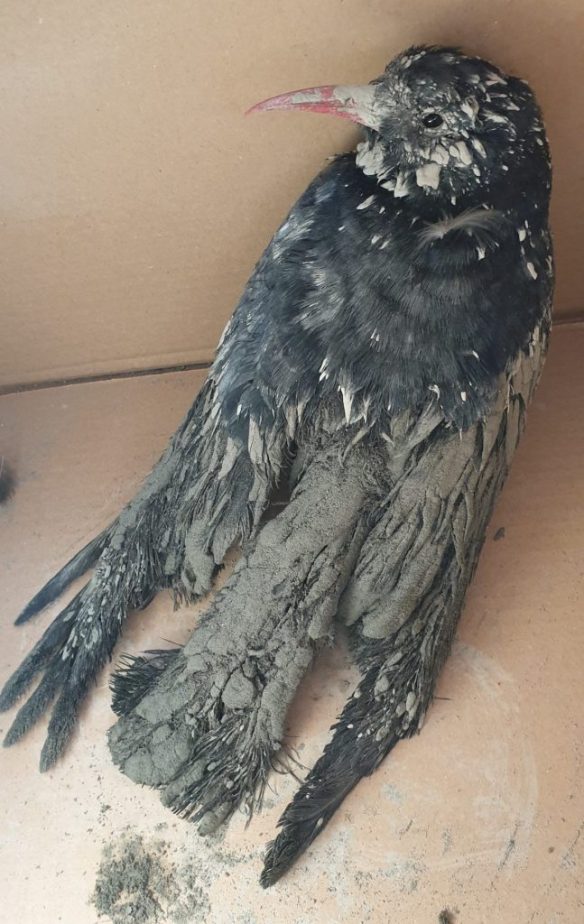Summary of the 2020 breeding season
We have ringed a total of twelve chicks this year from seven different broods. Three chicks have unknown parentage although I can narrow it down to three possible options. We also know that five chicks died bouldering or shortly post-fledge which brings the 2020 total to seventeen chicks. No doubt we would have recorded more if COVID-19 restrictions had not prevented us for checking in nests. In a way it doesn’t matter. The twelve that fledged and continue to fly around Jersey are the important thing.
Last month’s report sounded like we had a handle on which pairs had bred and which chicks had made it to the aviary for supplemental feed. We didn’t. Not entirely. None of the chicks had been ringed in the nest this year thanks to the pandemic situation. On some days there were numerous unringed, identical birds in the flock.
On 23rd June, Glyn opportunistically caught up two of the unringed chicks to pop on a plastic leg ring. Six days later I caught up four chicks with a licensed ringer including one Glyn had previously caught. We fitted them with the full complement of rings and took DNA for sexing.
Choughs very quickly wise-up to any catch-up plans. Repeated back to back catch-up attempts result in the birds avoiding the aviary. Which meant it took all of July (and the first week in August) to finish processing all of the unringed chicks.
As the month went on, we started to get a clearer picture on parentage. However, the longer you wait to ring a chick the more independent it becomes, i.e. feeds for itself. You need to see an adult physically feeding a youngster to know it is the parent. Of course, there is another risk with waiting. An unringed chick seen at the start of the month might get predated, fatally injured etc. and won’t be around by the end of the month. We certainly experienced that with Dusty and Chickay’s brood.
The twelve that survived bring the total wild population back up to 44 after the dip in 2019. We look forward to monitoring their progress.
Danny boy
One of the more memorable ringing events occurred on 16th July. I had completely different plans that day taking a film crew to Sorel along with a colleague, Dan, to film a piece for our Love your zoo LIVE event. As we arrived, I spotted an unringed chough in the aviary. Not only that, but it was also a new arrival. You can tell by their naivety when they are inside the aviary. Instead of navigating the open hatches and flying straight out they fumble around in blind panic if spooked. Trapping it and catching it up was super easy. There were no licensed ringers available at short notice to fit the metal ring, so we did the rest.
Dan was very excited especially when he found out he was going to be my glamourous assistance. I let him pick the ring colour with a caution of anything but pale blue or grey (hard to distinguish in the wild). He went with pale blue. Despite that we have named the chick Danny. The sexing result came back as a male just to add to the significance.
We spent two and a half hours filming out at Sorel that day. As expected, a lot ended up on the cutting room floor. Here is the video for those who missed it.
Zoo chicks take flight
The three youngsters left their nest box at the start of July. The first was out on the first! They look really good and follow mum to the ground looking for food. Still insisting mum feeds them, but watching and learning all the time when Penny is foraging for worms, larvae etc. We are lucky that the Zoo aviary is home to a few ant nests. As long as we time it right, we can turn over a stone and have hundreds of eggs available to the choughs. They just have to make sure they get to them before the ants have carried them away.
Sexing results came back on the 17th confirming we have three males. Two firsts for the Zoo; three chicks fledged, no females. These boys will head to the UK early next year to join either Paradise Park or Wildwood‘s breeding programme.
Chough travel plans continue despite Covid-19
Beaker and Beanie Baby continue to visit Grosnez and Les Landes whilst roosting at Plémont. They even made an appearance at the Sorel feed on 28th July. Maybe supplies were running low over in the west?

Cliffs adjacent to Les Landes racecourse offer plenty of roosting and nesting opportunities. Photo by Liz Corry.
Someone is certainly enjoying the east of the Island. More reports from Les Platons, Bouley Bay, Trinity, and flying over St Martin’s cricket pitch. We have Dave Buxton to thank for the latter. Licensed ringer and avid cricketer.
The pitch certainly looks inviting to a chough with all that short grass. The question is what lies beneath? Juicy grubs?














































































 By Catherine Firth
By Catherine Firth



 Catherine Firth carried out this research for her MSc in Endangered Species Recovery and Conservation at Nottingham Trent University. She is currently working as a Conservation Knowledge intern at Jersey Zoo.
Catherine Firth carried out this research for her MSc in Endangered Species Recovery and Conservation at Nottingham Trent University. She is currently working as a Conservation Knowledge intern at Jersey Zoo.
































 Staying on a funding and monitoring theme, we are very honoured to hear that Ronez Quarry have nominated the chough project for the
Staying on a funding and monitoring theme, we are very honoured to hear that Ronez Quarry have nominated the chough project for the 





